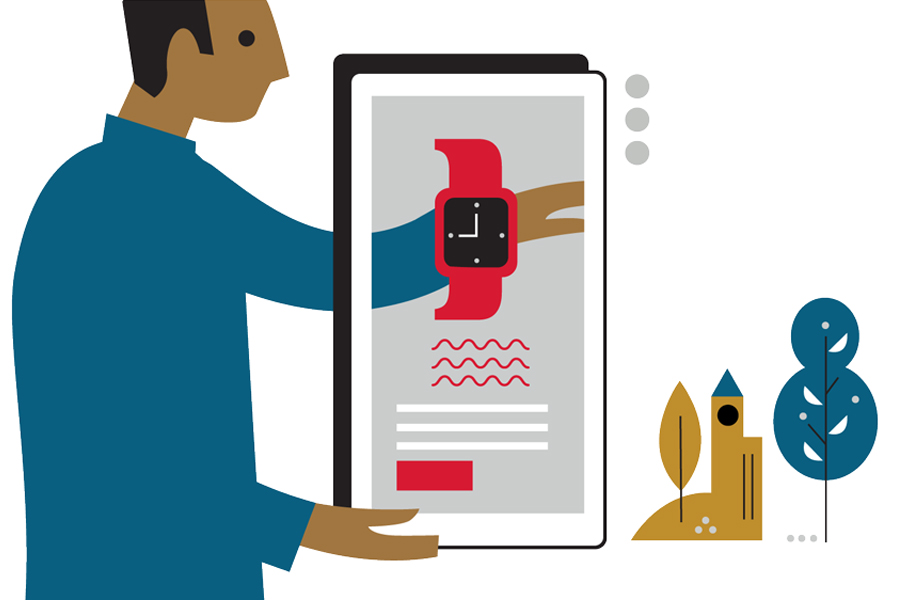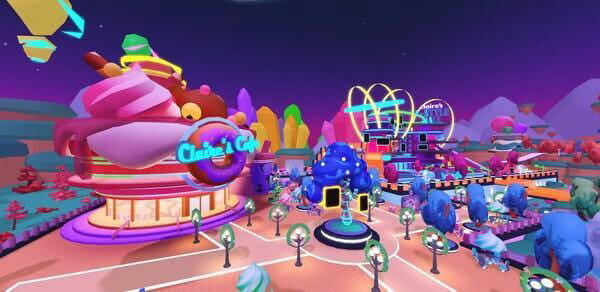Logistics
Industries
Technology & Innovations
E-commerce
E-commerce Fulfillment Services
Lease & Maintenance
Semi Trucks
Logistics
E-commerce
Lease & Maintenance
Buy Used Trucks

[Updated post from September 23, 2021]
Discussions about the future of the retail landscape often end up sounding like science fiction. Thanks to the COVID-19 pandemic and the rapid growth of e-commerce, we've seen trends initially forecast as being years out from the mainstream accelerate right to the present day.
Where e-commerce was once purely about speed and convenience, we're seeing brands prioritizing immersive experiences that put the shopper front and center to increase customer loyalty.
Enter: Virtual shopping.
Exploring retail spaces and trying products is no longer the domain of physical stores. When customers shop online, they now have more opportunities than ever to interact with brands on a deeper level, from trying out products to face-to-face customer service.
In this blog, we will explore how virtual shopping works, the benefits of virtual stores, and how some brands did start offering virtual shopping for themselves.
Virtual shopping refers to e-commerce experiences where online shoppers can browse and buy products within a digital representation of a physical store. Using technology such as Augmented Reality and Virtual Reality, virtual retailing reimagines the online shopping experience using 3D renderings of the in-store environment, virtual try-on tools, virtual assistants, and more.
In a virtual store experience, online customers get to ‘walk' around the storefront, enjoy product displays, and complete purchases – all from the comfort of their homes. These online sessions provide a unique fusion between the immersive nature of physical retail and the ease of shopping online.
Virtual shopping experiences can assist brands in addressing a variety of common pain points in e-commerce. For example, live video chat with store associates allows consumers to instantly connect with customer service like they do in-store, rather than waiting for a support ticket to be answered. Interactive quizzes, scavenger hunts, and brand activations help to make the online shopping experience as engaging as possible to secure more online conversions.
There is more than one type of virtual shopping experience available to consumers, spanning from entire storefronts to product visualization.
Virtual clienteling. Providing shoppers with a personalized experience is a growing expectation, especially within luxury verticals. White glove services in a virtual setting are more efficient for brands to execute than a retail store, while still providing a personal touch. This includes consultations, product recommendations, exclusive content, and more.
Virtual try-on. AR technology has made it possible for consumers to virtually 'try' items including accessories, apparel, and cosmetics before purchasing, reducing the likelihood of returns due to the wrong size, color, or fit.
Virtual placement. Large products, such as furniture and home decor, can be assessed using an AR filter that allows shoppers to 'place' items within the intended living space to check for size or suitability.
3-D virtual storefronts. Brands can build out an entire 3D-rendered store environment with the assistance of virtual shopping platforms. Online customers can navigate this space, interact with products, and make purchases.
Virtual shopping works by bringing together a mix of one or more of the technologies above, depending on what services a brand wants to offer customers. For example, if you've built out an entire storefront for virtual store visitors to navigate, you could add a 'fitting room' to house your AR try-on tool to maintain immersive storytelling. However, it's worth noting that the more e-commerce service types and activations you want your virtual store to have, the more complex it is to build and execute.
It's easy to dismiss virtual shopping as a fad, rather than a serious tool to enhance the online shopping experience. Until very recently, VR and AR experiences have been clunky at best. VR headsets and development come with a high price tag, limiting both who can experience it and which businesses can invest. Moreover, high-profile failures by the likes of Google Glass show that many consumers are still not open to the idea of wearable tech to enable these experiences.
But advances in mobile app technology – as well as the significant impact of the disruption to traditional brick-and-mortar stores during the COVID-19 pandemic – have turned virtual reality shopping into a viable experiential marketing and sales strategy that all retailers should be paying attention to.
According to an ARRIS Composites report, 70% of U.S. respondents believe that AR will become part of everyday life, while 82% said they planned to use AR and VR more often in the coming years. Furthermore, nearly 1 in 3 consumers own a device capable of advanced AR/VR experiences, while 15% plan to buy such a device in the next 12 months.
In sum, the rise of virtual shopping coincides with more willingness by consumers to experiment with new shopping technologies. Combined with the rise of mobile shopping and greater omnichannel connectivity, it's easy to see why virtual retailing is the next level of experiential retail.
E-commerce has experienced rapid growth because it offers convenient, self-directed shopping journeys. Consumers can place orders at any time of day (or night) without needing to contend with long checkout lines or busy retail associates.
But even the most seamless e-commerce experiences struggle to match the engagement of shopping in-store. Online customer service can make the brand experience feel clinical at best, designed for efficiency rather than enjoyment.
This is why many consumers still prefer to shop predominantly at brick and mortar stores. Shopkick's recent study found that 70% of consumers rate the ability to try on, touch, and see physical products as their favorite part of the in-store experience, followed by in-person interactions with sales associates (41%).
A virtual shopping experience offers brands a way to bridge this divide by bringing the best parts of the in-store experience online. From virtual assistants to answer queries to AR try-on tools, virtual stores give consumers the convenience of purchasing via an online store, but with the human touch that we associate with the in-store experience.
Brick and mortar retail has been dealt a rough hand over the past few years. The COVID-19 pandemic led to record store closures, while in-store retail restrictions put an end to normal operations.
It's no secret that the biggest pandemic success stories in the retail industry have come from brands that pivoted to e-commerce and digital shopping experiences. But it's more than just covid that makes brick and mortar a sometimes challenging channel for retailers to navigate.
The overhead costs of running a retail store can be high, especially in new markets and for smaller brands. And while temporary pop-up shops provide a more cost-effective alternative, they can be complicated and time-consuming to execute due to logistical challenges and finding the right location.
Virtual shopping offers customers a fresh retail experience that combines responsive customer service with connectivity of digital, making it a brilliant way to engage customers and achieve a true omnichannel experience.
Retail store activities such as refreshing merchandise and changing store displays can be time-consuming to execute, especially if there's some trial and error involved. With virtual retailing, you can achieve this in just a few clicks.
The decision to remodel your retail space can be tricky. Even with the best market research to hand, it's difficult to know how customers will respond to a new concept until they get to experience it for themselves. Virtual shopping gives brands the ability to A/B test different themes or displays – without having to go through the time and expense of changing an actual storefront.
For example, you could add a customer survey to your virtual store that asks customers to rate what they think of the experience. You could also use a virtual store remodel as a teaser campaign for what lies in wait for your physical stores or pop-ups, helping you to drive online and foot traffic.
The pandemic led to an acceleration in online shoppers using alternative delivery methods such as BOPIS and curbside pick-up which is continuing today. Add in the rise of ship-from-store fulfillment strategies, and physical retail stores can be put under a lot of strain.
O2O (online-to-offline) retail puts a lot of pressure on store locations to carry high volumes of inventory to meet the demands of online orders. This makes accurate inventory reporting difficult and increases the likelihood of stock-outs or excess inventory piling up.
Virtual shopping helps to take the pressure off brick and mortar by allowing consumers to browse products the same way they would in-store – including getting assistance from store associates, trying items on, and getting recommendations. If customers are more comfortable opting for home delivery, this helps to reduce pressure on stores to carry large volumes of inventory.
A notable disadvantage of in-store shopping is that data cannot be easily gathered before the point of purchase. You don't know what other products they may have considered, what store displays they engaged with most, or how many store visits were made before they committed to buying. In short, it's hard to know how the shopping experience has influenced a customer's decision to purchase.
E-commerce has been a game-changer because it's so easy to track a customer's entire shopping journey from beginning to end. Merchants can monitor ‘foot traffic' in real-time as customers move around online stores and track which products are browsed or end up in the shopping cart, enabling them to create tailored recommendations accordingly. In fact, nearly half of consumers (49%) say they've made an unintended purchase online as a result of a recommendation.
When combined with virtual shopping technology, data-gathering opportunities in e-commerce increase even further. In a 3-D environment, you can see how customers react to your merchandising efforts in a way you simply can't measure offline. The performance of e-commerce service offerings like virtual shopping assistants or AR tools can be mapped much more effectively when they're directly integrated into the shopping experience, rather than scattered across different apps or interfaces.

With its origins as a digitally-native beauty brand, Charlotte Tilbury understands the importance of engaging e-commerce experiences. They were among the first in the beauty space to adopt virtual shopping as a tactic to manage store closures imposed by the COVID-19 pandemic.
Launched in time for the 2020 holiday season, their first virtual storefront – powered by the virtual reality platform Obsess – was an exercise in branding as much as commerce. In addition to the usual ecommerce shopping capabilities, customers were guided around the 3D store environment by a ‘Charlotte' avatar and had access to personalized advice and product recommendations via virtual consultations.
The beauty brand followed this up with Charlotte Avatar, an immersive AR experience that brings Charlotte Tilbury herself into shoppers' very own homes and cities. Charlotte takes people on a journey through multiple realities, via shoppable 3D products, and live-streamed masterclasses. They can even invite friends to shop alongside them via video call, creating a true social commerce experience.

Accessories retailer Claire's has set its sights on building virtual experiences that go beyond the storefront. The recently-launched virtual world ShimmerVille is a completely original universe where visitors can customize their avatars with the latest Claire's merch, meet up with friends, explore Claire's mega-mall, and even look after their own pets.
With its predominantly Gen Alpha and Gen Z audience, immersive virtual shopping activities like these are increasingly vital for brands like Claire's, who are trying to capture these digital-first generations. Creating an entire ecosystem of activities aside from online shopping gives Claire's a broad scope to augment this world with new experiences as the brand evolves.

Sephora has always been ahead of the curve with its online shopping capabilities. So, it's not surprising that virtual shopping has a firm place within the beauty giant's experiential marketing strategy
Rather than a straight shopping experience, SEPHORiA is a retail activation designed to immerse customers in the brand's latest direction, including new brands, industry developments, and the importance of sustainable and minority-focused beauty.
Due to the COVID-19 pandemic, Sephora decided to turn its annual ‘House of Beauty' event into a virtual shopping experience during 2021 and 2022. The success of these virtual initiatives has led to the upcoming 2023 SEPHORA embracing a hybrid format, combining an in-person event with a virtual activation to achieve the best of both worlds. Virtual store visitors at House of Beauty will be able to create their own avatars, chat in real-time with Sephora Beauty Advisors, and earn Beauty Insider and NFTs through games.
By maintaining a virtual shopping component Sephora can resolve some of the limitations of events, namely that they can only be experienced by a limited number of people and are much harder to track.
“While we’re grateful for the return to an in-person experience, we also recognize the importance of making these events inclusive and broadly accessible to our global beauty community and will do so with free virtual components that are equally enriching,” says Jessica Stacey, senior vice president of external communications, event, and experiential marketing at Sephora.
Virtual stores take considerable resources to develop. While virtual shopping platforms can take a lot of weight off brands' shoulders, virtual shopping initiatives still take time and expertise to develop. It takes a lot of strategic direction and internal knowledge to offer virtual shopping experiences while maintaining brand consistency and not distracting from other marketing initiatives.
Ensuring adoption by consumers. While many consumers are eagerly embracing AR and VR activations, it's still outside the comfort zone for many. Others might see virtual experiences as a gimmick or struggle to understand how they can help them shop more easily. Brands need to ensure that virtual stores and tools are as accessible as possible and appeal to their target audience.
Virtual shopping cannot rival physical stores. While virtual stores bring e-commerce experiences closer to real life, they don't offer a complete replacement for brick and mortar. Consumers will still want to handle products in person and talk to store associates face-to-face for some purchases.
Where online shopping is traditionally designed for efficiency and removing interruptions, it became clear during the pandemic that consumers continue to crave the joys of exploration and unintended product discovery. The rise of virtual shopping is a testament to how e-commerce offers just as many experiential opportunities as brick and mortar - so long as you ensure your efforts remain customer-centered.
By bridging the gap between offline and online, the popularity of virtual stores suggests a significant shift in what a quality online shopping experience looks like. Whether it's more opportunities to try new products, earn loyalty points, or access better customer service, a virtual store is a high-value investment that addresses a range of touchpoints that increase customer retention and satisfaction.